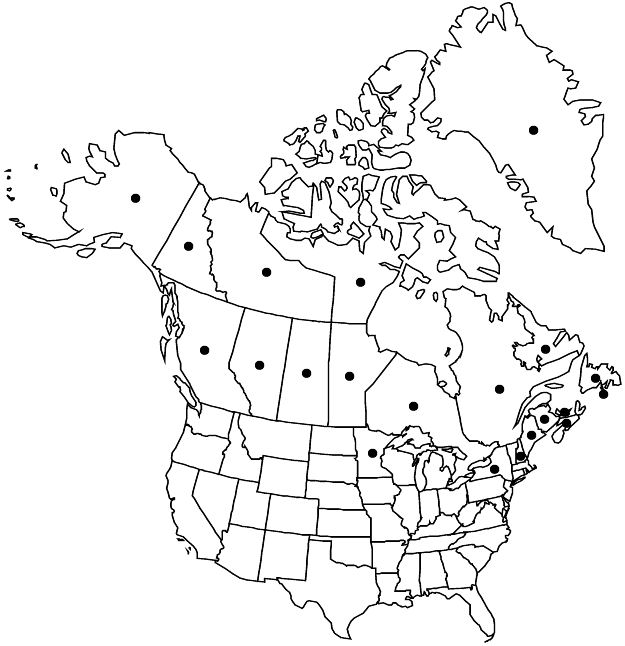Difference between revisions of "Rubus chamaemorus"
Sp. Pl. 1: 494. 1753.
FNA>Volume Importer |
imported>Volume Importer |
||
| (6 intermediate revisions by 2 users not shown) | |||
| Line 12: | Line 12: | ||
|name=Chamaemorus anglica | |name=Chamaemorus anglica | ||
|authority=Greene | |authority=Greene | ||
| − | }}{{Treatment/ID/Synonym | + | |rank=species |
| + | }} {{Treatment/ID/Synonym | ||
|name=C. norwegica | |name=C. norwegica | ||
|authority=Greene | |authority=Greene | ||
| + | |rank=species | ||
}} | }} | ||
|hierarchy=Rosaceae;Rosaceae subfam. Rosoideae;Rosaceae tribe Rubeae;Rubus;Rubus chamaemorus | |hierarchy=Rosaceae;Rosaceae subfam. Rosoideae;Rosaceae tribe Rubeae;Rubus;Rubus chamaemorus | ||
| Line 30: | Line 32: | ||
|elevation=0–1300 m | |elevation=0–1300 m | ||
|distribution=Greenland;St. Pierre and Miquelon;Alta.;B.C.;Man.;N.B.;Nfld. and Labr.;N.W.T.;N.S.;Nunavut;Ont.;P.E.I.;Que.;Sask.;Yukon;Alaska;Maine;Minn.;N.H.;N.Y.;Eurasia. | |distribution=Greenland;St. Pierre and Miquelon;Alta.;B.C.;Man.;N.B.;Nfld. and Labr.;N.W.T.;N.S.;Nunavut;Ont.;P.E.I.;Que.;Sask.;Yukon;Alaska;Maine;Minn.;N.H.;N.Y.;Eurasia. | ||
| − | |discussion=<p>Rubus chamaemorus is circumboreal; it is presumed to be extirpated from New York, where it was known only from a single population on Long Island, far removed from the next southernmost localities in northern New Hampshire.</p><!-- | + | |discussion=<p><i>Rubus chamaemorus</i> is circumboreal; it is presumed to be extirpated from New York, where it was known only from a single population on Long Island, far removed from the next southernmost localities in northern New Hampshire.</p><!-- |
| − | --><p>Rubus chamaemorus is defined by its unarmed stems, simple, coriaceous, and plicate leaves, unisexual flowers, and golden yellow to reddish fruits. Rubus chamaemorus is likely an ancient allopolyploid (K. V. Ambrose 2006).</p><!-- | + | --><p><i>Rubus chamaemorus</i> is defined by its unarmed stems, simple, coriaceous, and plicate leaves, unisexual flowers, and golden yellow to reddish fruits. <i>Rubus chamaemorus</i> is likely an ancient allopolyploid (K. V. Ambrose 2006).</p><!-- |
| − | --><p>The edible fruits of Rubus chamaemorus are highly valued in northern regions for consumption fresh and in yogurt, jams, syrups, and juices. An alcoholic beverage is made from the fruits and sold commercially in Newfoundland, Quebec, and Finland.</p> | + | --><p>The edible fruits of <i>Rubus chamaemorus</i> are highly valued in northern regions for consumption fresh and in yogurt, jams, syrups, and juices. An alcoholic beverage is made from the fruits and sold commercially in Newfoundland, Quebec, and Finland.</p> |
|tables= | |tables= | ||
|references= | |references= | ||
| Line 41: | Line 43: | ||
-->{{#Taxon: | -->{{#Taxon: | ||
name=Rubus chamaemorus | name=Rubus chamaemorus | ||
| − | |||
|authority=Linnaeus | |authority=Linnaeus | ||
|rank=species | |rank=species | ||
| Line 56: | Line 57: | ||
|publication year=1753 | |publication year=1753 | ||
|special status= | |special status= | ||
| − | |source xml=https:// | + | |source xml=https://bitbucket.org/aafc-mbb/fna-data-curation/src/2e0870ddd59836b60bcf96646a41e87ea5a5943a/coarse_grained_fna_xml/V9/V9_45.xml |
|subfamily=Rosaceae subfam. Rosoideae | |subfamily=Rosaceae subfam. Rosoideae | ||
|tribe=Rosaceae tribe Rubeae | |tribe=Rosaceae tribe Rubeae | ||
Latest revision as of 22:57, 5 November 2020
Herbs, (0.5–)1–2.5(–3) dm, unarmed. Stems from rhizomes, erect, rarely woody basally, sparsely hairy, sparsely stipitate-glandular distally, not pruinose. Leaves deciduous, simple; stipules broadly ovate to oblong, 3–6 mm; blade reniform or orbiculate, 2.5–6 × (3–)5–8(–12) cm, base cordate, 3–7-lobed, lobe apices rounded, margins finely doubly serrate or dentate, abaxial surfaces sparsely hairy, sparsely to moderately stipitate-glandular along veins. Inflorescences 1-flowered. Pedicels pubescent, sparsely to densely short- to long-stipitate-glandular. Flowers unisexual; petals white, obovate, (8–)10–15(–18) mm; filaments filiform; ovaries glabrous, styles filiform, glabrous. Fruits golden yellow to orange or reddish, globose, 1.2–1.5 cm; drupelets (5–)10–20, moderately coherent, separating from torus. 2n = 56.
Phenology: Flowering May–Aug.
Habitat: Bogs, muskeg, wet meadows, mossy woods, boreal forests, peaty tundra, lichen peat polygons, exposed sandy areas, lakesides, gravelly stream beds, rock outcrops
Elevation: 0–1300 m
Distribution

Greenland, St. Pierre and Miquelon, Alta., B.C., Man., N.B., Nfld. and Labr., N.W.T., N.S., Nunavut, Ont., P.E.I., Que., Sask., Yukon, Alaska, Maine, Minn., N.H., N.Y., Eurasia.
Discussion
Rubus chamaemorus is circumboreal; it is presumed to be extirpated from New York, where it was known only from a single population on Long Island, far removed from the next southernmost localities in northern New Hampshire.
Rubus chamaemorus is defined by its unarmed stems, simple, coriaceous, and plicate leaves, unisexual flowers, and golden yellow to reddish fruits. Rubus chamaemorus is likely an ancient allopolyploid (K. V. Ambrose 2006).
The edible fruits of Rubus chamaemorus are highly valued in northern regions for consumption fresh and in yogurt, jams, syrups, and juices. An alcoholic beverage is made from the fruits and sold commercially in Newfoundland, Quebec, and Finland.
Selected References
None.